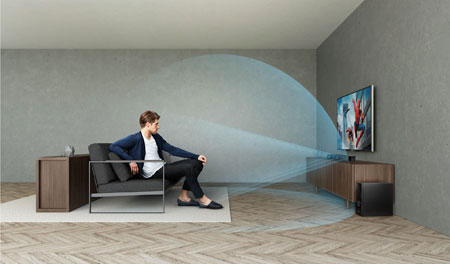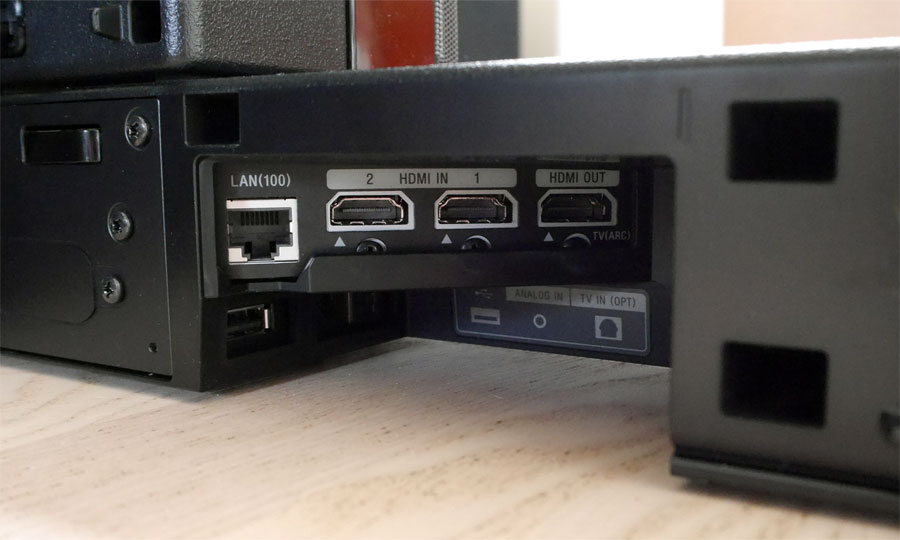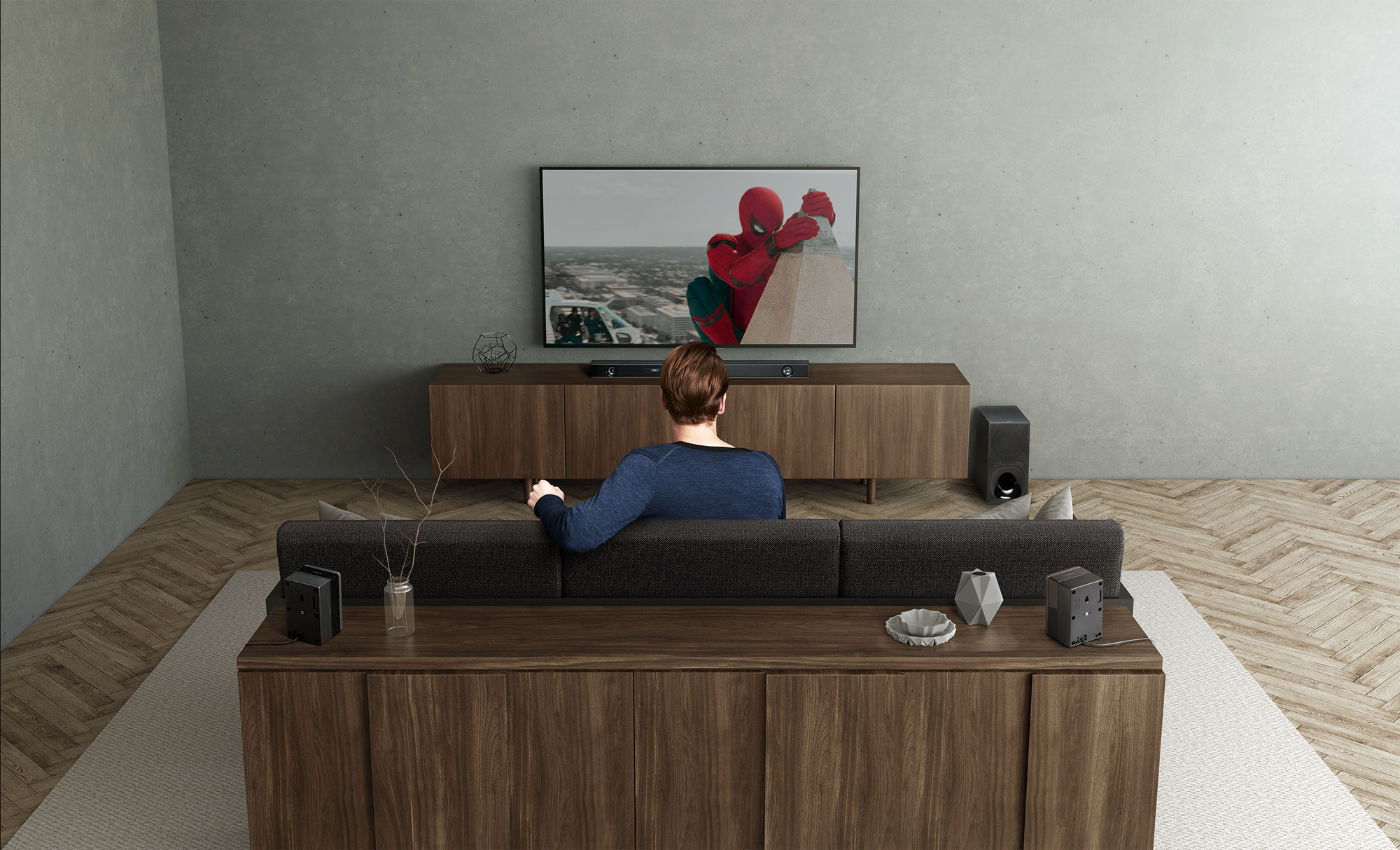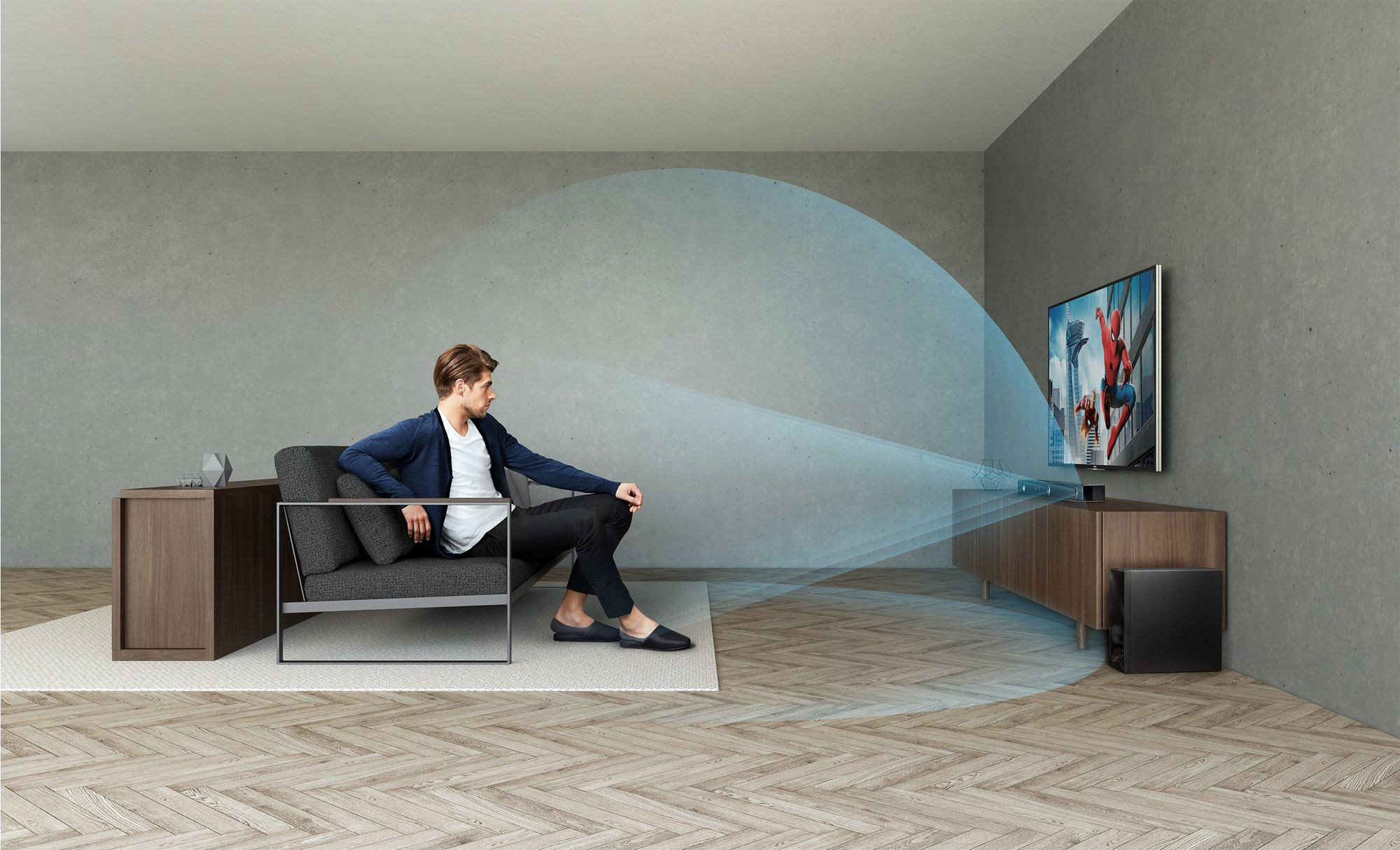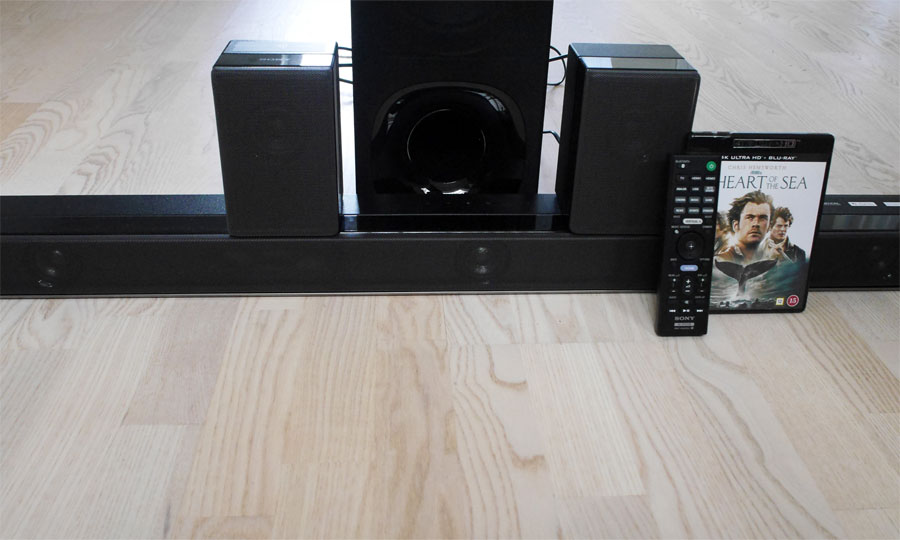Review: Sony HT-Z9F (HT-ZF9) Atmos
First impressions - Ports & formats - A new approach - Set-up - Sound - Movies - Sound - TV - Sound - Music - Conclusion
We have previously reviewed Sony’s first Dolby Atmos soundbar HT-ST5000. HT-Z9F in the US and HT-Z9F in Europe is a more affordable version with optional rear speakers, which was one of our main gripes with the flagship model. The soundbar competes in a price class where you typically get a lot of performance for your money but Sony is one-upping most of its competitors by adding support for both Dolby Atmos and DTS:X.
Object-based audio technology can improve the listening experience but does Sony’s more affordable soundbar have capable enough hardware? Is Dolby Atmos ready for this price point? Here is our review of Sony HT-Z9F.Price and retailers:
Sony HT-ZF9 - specifications
(HxWxD) 6.4 x 100 x 9.9 cm (soundbar)
38.2 x 19 x 38.6 cm (subwoofer)3.1 kg (soundbar)
8,1 kg (subwoofer)2x HDMI (2.0)
Optical
Analog (mini jack)
1x Ethernet
1x USB1x HDMI (eARC) 3.1 channels
400W total effect
Dolby Digital
Dolby Atmos
Dolby TrueHD
DTS
DTS:X
DTS-HD MA4K pass-through
HDR10 pass-through
Dolby Vision pass-through
HLG pass-throughWiFi (5GHz n standard)
Chromecast
Bluetooth
Spotify ConnectUser manual
Remote control
Optical cable
Wall bracketSubscribe to our Newsletter, Facebook, twitter or RSS to receive notice when new reviews are publishedFirst impressions
The package is classic Sony – and most other traditional HiFi manufacturers. Meaning boring. It has all the right logos and stickers outside to indicate that it supports the latest audio formats and technologies, and while this is informative, it is not particularly elegant. Unboxing the soundbar is trivial and Sony could have made the entire process of unpacking and setting up everything more inviting but of course the product is of main interest here.
Sony has included the most essential components; the soundbar, subwoofer, remote control, power cables, and a thin, cheap optical cable to get you started. There is no HDMI cable included, despite HDMI being the only feasible option if you want to enjoy the full capabilities of the soundbar.
HT-Z9F brings some design innovation to the table. In my humble opinion it actually looks more exclusive than the ST5000 flagship model that sells for double the price. That primarily comes down to the piano-lacquered top plate. True, it is made from plastic but from a distance it goes well hand in hand with the bottom plate that is meant to look like metal.
To me, this design approach seems a little more modern compared to the conservative style of the more expensive ST5000. You can remove the front grill to expose the units, which may appeal to users who appreciate the engineering effort that goes into a speaker.Ports & formats
Sony has decided to lower the HDMI ports into the soundbar in a rather curious way in order to make wall mounting easier. I like their thinking but unfortunately it makes it quite hard to access the innermost HDMI port, which is the HDMI port that supports ARC (Audio Return Channel) – the HDMI port that must be connected to your TV (since we conducted our review, Sony has issued a firmware update that adds support for HDMI eARC).
It is an imperfection and it can be overlooked but there has to be a more elegant way because right now I fear that a moment of negligence could break the port or cable connector. Speaking of HDMI ports, there are two HDMI 2.0b (with HDCP 2.2) inputs. The two HDMI ports also support pass-through of 4K, HDR10, Dolby Vision, and HLG – the whole package. Pass-through support is there to ensure that you a video signal can pass-through the soundbar untouched to the TV. However, two HDMI ports is the absolute minimum and some users may find themselves longing for more.
There is an optical input, AUX 3.5 mm (mini jack) and USB for playback of local media. Next to the HDMI and USB ports, there is a LAN port. The soundbar also has built-in WiFi, which I used throughout the test without encountering issues or limitations.
Like most other recent Sony product, HT-Z9F has built-in Chromecast, which enables you to stream music wirelessly to the soundbar from a smartphone or tablet. Furthermore, it supports bluetooth but Sony has passed on Apple’s Airplay 2.
Lastly, the soundbar supports Hi-Res Audio but due to the natural limitations of a compact soundbar design there are no real audio quality benefits to be had from HD audio. Still, it is fine that users have the opportunity and can enjoy hassle-free playback of HD audio format, if they already have a music library in the format.A new approach from Sony
One of the first things that I noticed after the official announcement is that HT-Z9F supports wireless rear speakers (so-called Sony SA-Z9R) for a full surround setup. We applaud this development since it was one of our main gripes with the flagship HT-ST5000.
Sony HT-Z9F can of course function without the optional rear speakers. It is a 3.1-channel soundbar, meaning that it has three channels; left, right, and center, plus a wireless subwoofer. On the other hand there are no up-firing speaker units. For now, Sony has decided to reserve this feature for the flagship ST5000 but it effectively means that there is no dedicated hardware for overhead sounds in Dolby Atmos and DTS:X. Sony claims that Z9F can simulate the overhead sound effects such as a helicopter flying or thunder through a type of virtualization. We will examine performance in a moment.
For this review, we had at our disposal a pair of rear speaker (SA-Z9R) and they look decent together with the Z9F soundbar. The plastic looks a little cheaper but it is forgivable considering that Z9F is a simple rectangular box.
These are active and wireless rear speakers meaning that you have to plug them in to a power outlet – a classic type of rear speaker for an all-in-one surround system. Again, Z9F has speaker units meant to project sound in the horizontal plane but no up-firing speakers. Even if you are prepared to invest more in this system, there is no way to add dedicated hardware for vertical sound, which is part Dolby Atmos and DTS:X. Other manufacturers have started adding up-firing units to rear speakers that can enter into a Dolby Atmos / DTS:X setup so even though we are happy that Sony has added the option to add rear speakers, we still miss some flexibility.
You can use a classic bracket solution and there is also the option to mount the speakers directly on a screw sticking out from the wall. If you want them angled, you should invest in a universal bracket solution.Set-up
It was easy to set up the soundbar and rear speakers. You simply connect the power cables, after which the rear speakers automatically connect – almost like an integrated system. If you want to use the built-in Chromecast function you must set-up WiFi.
The soundbar comes bundled with the same remote control that Sony has been supplying for years. It is a poor remote in every imaginable way and at times it even fails to deliver its command via infrared. It is simply too directional. Luckily, you can put it away in a drawer because the soundbar supports HDMI CEC, meaning that you can use your TV remote to adjust volume, regardless of brand. Your TV simply needs to support HDMI CEC, which has been a standard feature in TVs for years now.
Audio settings
It has become custom that manufacturers include various video modes in TVs and likewise audio modes in soundbars. The audio modes in Sony HT-Z9F have been pre-programmed for movies, sport, and music. In addition, Sony is offering a night mode, which is designed to primarily limit bass.
While audio modes can prove useful, especially the night mode, we strive for the most neutral sound to ensure that we hear exactly what the creator intended. Specifically for HT-Z9F, it offers a ‘Standard’ mode, which is the one that I recommend using as it offers very balanced sound. I will get to that in a moment.
The ‘Cinema’ mode has too heavy bass, and although it adds some extra power to action movies, it sounds a little intrusive at times. Considering how much effort and time sound engineers put into creating a soundtrack, it seems wrong not to select the ‘Standard’ mode and experience what the creator intended for you to hear.
The ‘Sport’ mode is designed to tone down commentary while emphasizing the stadium atmosphere. The idea is to create the illusion of being present at the stadium. It works to some degree but obviously it cannot mimic the roar of a crowd. There is upside here because sports are rarely broadcast in Atmos or even standard surround.
Sound – Movies
After everything had been set-up, it was time to conduct my listening tests. The first movie was American Sniper on Blu-ray. It is also one of the few HD movies with a Dolby Atmos soundtrack. Object-based sound in Dolby Atmos or DTS:X is more commonly found on the UHD Blu-ray release – and now increasingly on streaming services such as Netflix and iTunes.
Treble performance was sharp and accurate. Gunshots or explosions were reproduced accurately and I almost felt that bullets were flying across the room. Compared to the flagship HT-ST5000, Z9F lacks some character in for example metal-against-metal sound effects but you can easily tell a light machine gun apart from a pistol.
American Sniper is one of the early Dolby Atmos releases and the creators have utilized of the full spectrum that the object-based audio format supports. For example, it does not include many overhead effects but the sound still felt encompassing and rich. A good Atmos mix can make a soundbar’s audio performance markedly more potent than what you would expect just by glancing at it. Sony can take some credit but a lot of this also has to do with nature of object-based audio.
While American Sniper is fairly conventional in the way it mixes audio, Mad Max delivers a more creative approach to the cinematic, visual and audio side. Even though Mad Max was released in 2015 and despite it being one of the early Dolby Atmos releases, it includes some rich effects – and big explosions. It is a great movie for testing and demonstrating Dolby Atmos because many scenes cover the full sound spectrum. It includes lots of moving sound effects, including objects moving left to right, top to bottom, and from afar to close. It may sound trivial but if you know the movie well, it is great for testing how a soundbar performs and whether it can faithfully reproduce these nuances in distance, position, volume, and other aspect. Great Dolby Atmos performance is not simply a matter of left, right, up, and down. A good sound system should also be capable delivering audio in a three-dimensional space because the object-based soundtrack includes such information through object-encoded sounds and metadata. Ideally, as a viewer, you should be able to distinguish not just the direction but also the position of sound.
Soundbars without support for object-based audio will not be able to take advantage of this type of three-dimensionality because the information is simply not included in the former DTS and Dolby audio formats that are based on the concept of fixed audio channels (left/right front, center, left/right rear). Ideally, you need a big setup to take full advantage of object-based audio but what you gain with DTS:X and Dolby Atmos is also a 3D effect. It can sound a lot more realistic.
In the past, we have listened to flagship soundbars that manage to significantly improve the 3D audio effect but Z9F struggles a bit in this area. It reproduces sounds in the horizontal plane with decent accurate but it fails to expand audio to the vertical plane. Sony claims that Z9F can simulate overhead sound but nothing beats actual sound waves.
Typically, most overhead sound effects fall in the frequency range that we associate with treble or mid-tones – for example gunshots or voices – since our ears have not adapted to determine directionality for bass. There are plenty of overhead effects in Mad Max but Sony HT-Z9F, with its missing up-firing units, did not convince me that it is actually capable of simulating these effects in any meaningful way.
The effect of Dolby Atmos or DTS:X is significantly limited by Sony’s hardware choices. Listening to HT-Z9F, I was missing 3D effects and accuracy. I was also missing overhead effects. My impression is that soundbars in this price range are stuck in a kind of limbo between very decent performance and proper Atmos / DTS:X performance. If it is the Atmos experience that you seek, you should probably invest more.
It is a shame because I had hoped that Sony Z9F plus a small extra investment in rear speakers would turn out to be a decent Atmos solution but instead it has reinforced the notion that you have to spend a good amount of money for a proper Atmos experience – at least for now.
Of course, Dolby Atmos is just one element. Turning our attention to its general audio performance, we were impressed with how clear human voices appear. Z9F manages to reproduce those nuances and characteristics that allow a viewer to close his eyes and still recognize an actor’s voice. For example Bradley Cooper in American Sniper. Less capable speaker systems will often subdue these characterizes simply because they lack precision.
Z9F comes bundled with an active, wireless subwoofer that completes the soundstage. It is powerful enough to supplement the soundbar and reasonably tuned, although I found it a bit too dominant so I preferred to tone it down a little but. On the remote, there are two dedicated buttons for controlling the subwoofer’s levels. The same remote allows you to quickly adjust the rear speakers. It is a thing that you do only once after which you can put the remote control a drawer and just use your standard TV remote to adjust volume.
The subwoofer delivers potent explosions and is relatively accurate. It never distorts and it does not lack power either. For movies, I think it is a great choice that is well balanced to both soundbar and rear speakers. If you are a fan of action and sci-fi movies, and want to impress your friends, it can be adjusted to go even higher but as said earlier I think the sweet spot is to tone it down just a little bit.
I am a proponent of neutral sound that respects the creator’s intent, which is why I dislike this trend of enhanced bass in especially mid-range sound systems. Bass sells so it makes me happy to see Sony opt for a balanced soundstage in HT-Z9F.
Sound – TV
While great movies tempt us to upgrade our TVs and sound systems, most of us still watch TV programs and sports on a weekly basis. It is important that a soundbar is versatile. Movies and TV programs tend to be quite different in their audio characteristics. Movies tend have amazing effects, whereas for TV programs you want to be able to clearly discern voices.
Luckily, most manufacturers design their soundbars for both use cases. Sony Z9F is not the exception. It can reproduce clear and accurate voices and dialog, even a low volume levels. If you hear mumbling, blame the recording because this soundbar has capable enough hardware and well balanced tuning.
While this may be obvious, I still like to point out that for TV programs, Dolby Atmos and DTS:X support plays no role. TV channels are generally broadcast in either stereo or low-bitrate 5.1 surround. If you are primarily watching TV channels, buying an Atmos-capable soundbar is probably overkill. Technology evolves but by the time Atmos arrives for broadcast, you can most likely buy a better soundbar for far less.Sound – Music
I have a standard playlist for testing speakers. For this test I was transmitting music to HT-Z9F via Chromecast through Spotify Premium. I have the same playlist on a USB key in FLAC format but for a soundbar in this price class you will not be able to hear any substantial improvements. Of course, Sony will tell a different story and it is probably true that there are specific instances where small nuances will differ but most often these effects tend to be the result of adjustments or an equalizer.
Soundbars are not typically designed for music listening. Electronic music revealed that the tweeter at times struggled to keep up with the fast rhythms; some effects are inadvertently getting mixed together. It is not a serious error but it may discourage some buyers who seek an all-in-one solution for the living room. Other users may never notice this, especially when playing music at high volume. This was expected but I think it is still worth pointing out that soundbars are first and foremost TV speakers.
Vocals on the other hand are razor sharp and it appears that Sony has focused specifically on mid-tone performance. This also benefits music because besides vocals, some drums and a large portion of the guitar range require good mid-tone performance.
The subwoofer has clearly been designed for watching movies but it has surplus power and delivers a decent music performance. Its limitations are found mainly when listening to genres such as metal and electronic music where the bass line has to be 100% crisp.Conclusion
With HT-Z9F, Sony has created a good soundbar that performs better than expected in some disciplines but there are some low-hanging fruits that Sony hasn’t picked. The company insists on bundling the same tired remote control across its product categories. It is not up to par with modern standards and competitors’ remotes are easier to use and more ergonomic.Ad:However, the biggest limitation is the lack of up-firing speaker units. HT-Z9F is sold as a Dolby Atmos / DTS:X soundbar but it lacks the hardware to reproduce overhead sound effects, which significantly impacts the Atmos listening experience. Sony is using software to visualize overhead effects and while I cannot deny that I sensed some sound effects over my head, I am not convinced by the results. After having reviewed and listened to other soundbars with up-firing units, it is hard to accept this watered-down effect. How much would it actually cost Sony to include two up-firing units? If the consumer product ended up being $50-100 more expensive, I think it would definitely be worth it.
Comparing HT-Z9F to the flagship (and more expensive) HT-ST5000, Z9F is clearly less capable. ST5000 has better and livelier treble and mid-tone performance but the biggest difference in terms of speaker unit quality is probably the subwoofer. It is a class or two better on ST5000 – especially while listening to music.
Dolby Atmos and DTS:X support is a nice addition and we will surely see it adopted in even more affordable products in the coming years. HT-Z9F has its moments and if you are buying UHD Blu-ray discs, Atmos is becoming a standard feature so you do not even have to invest a lot of extra money. Not long ago, Apple TV 4K and iTunes gained support for Atmos.
Dolby Atmos has stronger momentum than DTS:X but we are happy to see both formats supported by Sony. However, if you want to enjoy Atmos and DTS:X, we recommend that you invest in a system with up-firing units at minimum. Or better yet; real ceiling speakers if your living space can accommodate it.Price and retailers:
Audio quality is assessed as overall audio quality, including treble, midtone and bass, as well as precision and balance. We also evaluate to what degree supported audio formats affect the overall audio experience.
Features is assessed based on functionality (ports, format support, wireless audio protocols etc.) as well as the applicability.
User experience is evaluated on the basis of user friendliness, speed, reliability, build quality, choice of materials, and day-to-day use of the product.
Total score is weighted: 50% Audio quality, 25% Features, 25% User experience.
All scores are calculated based on a moving maximum target, defined by what we currently consider the best on market. Each score is then presented as a percentage. This means that a score will fall over time as new and better products set new standards. This allows you to compare product scores across years. A score of 100% in a given category means that it is consider the best available product in this category to date.Click for a more detailed explanation of the score system and Awards.
Balanced soundbar & sub
Plug & Play
Atmos & DTS:X support
Value-for-money
Optional rear speakersNo up-firing speakers (Atmos)
Cheap remote
Locations of HDMI inputs
Subwoofer is weakest link for musicNearest competitors

